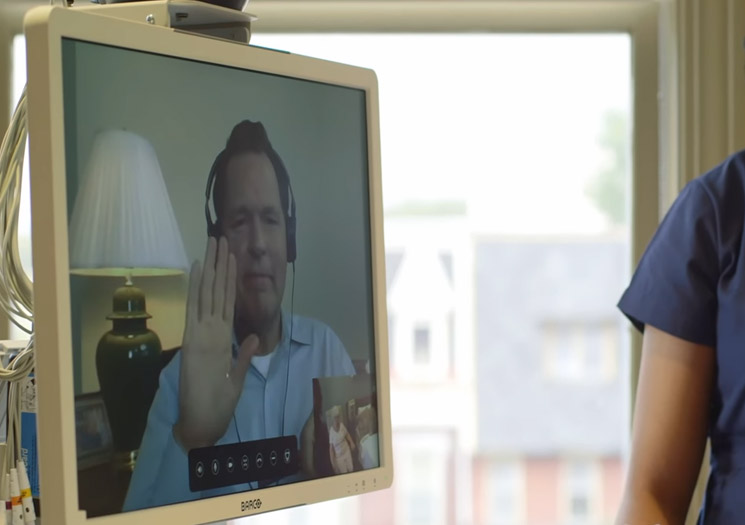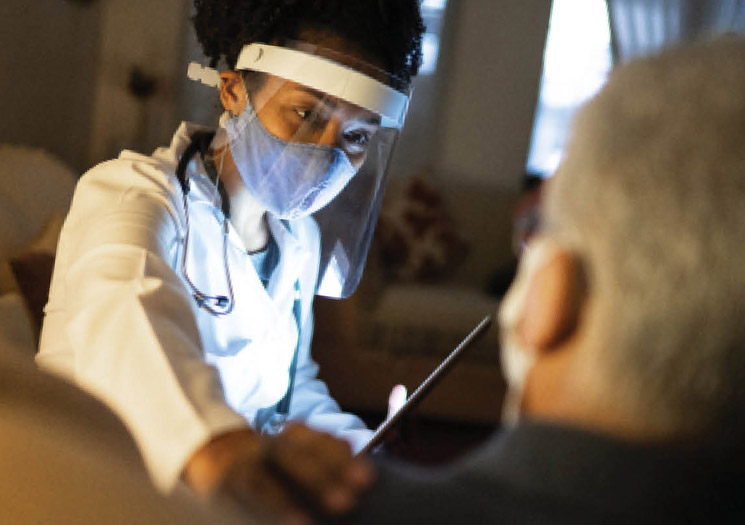- Find a Provider
-
Services
-
Redeemer Health provides compassionate care across every stage of life.
- View all Services
- Health Care
- Cancer Care
- Heart Care
- Hospital at Home
- Maternity Care
- Pediatric Urgent Care
- More Health Care Services
-
- Patients & Visitors
- Locations
- Careers
categories:

Providing expert bedside medical care as soon as an unanticipated medical concern arises through our new telemedicine system has been a hit within Holy Redeemer’s Life Care communities according to Dr. Mark Mullen, who helped to bring this technology to the Lafayette Redeemer and St. Joseph Manor Life Care communities.
In comparison to a telephone assessment conducted by on-call physicians, the telemedicine system offers several state-of-the-art advantages. According to Dr. Mullen a face-to-face assessment—which telemedicine makes possible—is an important factor to help reduce potentially unnecessary trips to the hospital.
The system, which includes a special HIPPA-compliant video platform, Bluetooth stethoscope, pan-tilt camera to survey patients from different angles, special high-resolution wound camera, and EKG system provides visual AND audio capabilities. If nursing staff notices a major change in a resident’s condition, the telemedicine system gives them immediate access to an experienced, board-certified geriatric physician who uses the interactive video-based platform, special pan-tilt camera, and digital medical instruments to assess the resident.
Within our Holy Redeemer Life Care communities, the lasting benefits of telemedicine are taking root. When telemedicine physicians determine an emergent condition is not life-threatening, residents have been able to receive treatment in the comfort of their apartment or room because of the quick intervention and avoid a visit to the hospital. The attending physician can then follow up on the plan of care initiated by the telemedicine physician.
“Telemedicine—especially during the after-hours—is working out extremely well for both residents and doctors,” says Dr. Mullen.
For more information about Holy Redeemer Life Care communities visit Redeemer Life Care.
categories:

Philadelphia, PA - June 30, 2020 - Thirteen Southeastern Pennsylvania hospitals and health systems recently announced a collective commitment to combat racism, inequality and discrimination in all its forms. The partnership will ensure that healthcare organizations across the region are aligned in fostering a diverse, equitable environment and addressing healthcare disparities.
Over the past several weeks, protests and calls for racial justice and equality have intensified following the tragic murders of George Floyd, Breonna Taylor, Rayshard Brooks, Ahmaud Arbery and Elijah McClain. Recognizing the responsibility that hospitals have for the safety and health of their community, healthcare leaders across the country are heeding the call to eradicate racism and evaluate the role that systemic racism has had in the healthcare industry.
“Racism is a healthcare issue. We cannot address socioeconomic factors that are barriers to healthcare access—like trust in healthcare providers, income, transportation, education and housing—without acknowledging that systemic racism has caused these issues to be more prevalent in communities of color. If we are truly committed to the health of our patients and neighbors, we must work together to ensure that no one is overlooked, dismissed or underserved simply because of the color of their skin,” the group said in its letter of commitment.
As a healthcare destination for patients across the world, Philadelphia has a longstanding reputation for being on the cutting edge of medical research, innovation and education. Still, health indicators demonstrate that there is still more work to do to serve neighbors and patients right here in our city. A 2019 Health of the City report found that health issues like childhood asthma, heart disease, hypertension, and HIV were far more prevalent in Philadelphia than in other major US cities.
By pledging their support to this commitment, participating hospitals and health systems have agreed to address these health disparities. Additionally, each participant has committed to fostering diverse, inclusive environments by hiring and promoting leaders of color, establishing relationships with community partners to address chronic health conditions, improving access to primary and specialty care, and increasing the collection of data to understand—and ultimately better meet— the health needs of our patients and community.
Attached, please find a formal letter of commitment and list of participating organizations.
categories:

It’s important to prepare ahead of time so you can feel comfortable and make the most of your appointment. These tips can help ensure you receive the care you need
- Talk to your insurance company about coverage and copays.
- Call your practitioner’s office to make an appointment. Once you make an appointment, your Holy Redeemer practitioner will send you details about log in.
- Before your appointment, make sure whatever device you’re using is fully charged/plugged in, and that you have a reliable internet connection.
- Write down your questions, as well as any symptoms and how long you’ve had them.
- Gather your medications and any equipment (thermometer, scale, blood pressure cuff, etc.) you’ll need.
- Find a quiet space close to your router or computer (the closer your wi-fi signal, the better the connection).
- Turn off the TV and any noisy devices like HVAC units and ceiling fans. Put your pets in another room and mute any desktop notifications.
- Make sure the light is in front of you so your practitioner can see you clearly.
- Place your phone or tablet in a holder or lean it against something heavy rather than holding it.
- Use headphones for privacy and to minimize any feedback or static.
- Take notes and confirm you understand everything before hanging up.
To find a Holy Redeemer Telehealth provider, visit our Physician Directory. For maximum convenience, you can further filter your search by medical specialty and location.
categories:

Since the start of the pandemic, patients of Holy Redeemer Home Care and Hospice have witnessed first-hand how the dedication of Home Care nurses, therapists, aides, and social workers face challenges with inspiration and resolve.
To maximize safety, the Home Care and Hospice team has continued to adapt to changing guidance from the Centers for Disease Control and Prevention (CDC), as well as state and local authorities to protect themselves and their patients. Despite a new “norm” that requires more time and attention to screenings, protective equipment, and sanitation, the Home Care and Hospice team continues the Redeemer tradition—to Care, Comfort, and Heal—with great flexibility, discipline, and commitment.
In fact, many members of the Home Care and Hospice team point out how they remain more determined than ever to help patients and families cope during these challenging times. “One key issue we see is dealing with transportation challenges and obtaining medications when usual caregivers cannot be in physical contact due to COVID-19 precautions,” says Amanda Hiner, an RN who has worked with Home Care patients for almost two decades.
Alicia Campbell, who directs Holy Redeemer Home Care and Hospice Mercer County, reinforces Amanda’s observation. “Many patients view us as a lifeline because family members and other caregivers are not able to attend to their needs due to visitation restrictions,” she says.
It is exactly this devotion to patients that, during the height of the pandemic, enabled Holy Redeemer Home Care and Hospice to continue services for new and existing patients—including those coping with COVID-19—when other care options began to narrow.
Even more, the Home Care team devised a new protocol, called the Pulse Ox Program, to promote early detection of COVID-19 complications. The program actively monitors a patient’s symptoms through a combination of home visits, symptom monitoring, and phone calls. Additionally, the Home Care nurse can arrange for additional medical intervention if it is needed.
“Having an in-home monitoring program supports our care initiatives by alerting us early to changes in a patient’s health status,” says Alicia.
Holy Redeemer Home Care and Hospice continues to strictly follow Safe Care protocols. Every day, team members are carefully screened for COVID-19 symptoms. Those who present with possible symptoms are further evaluated by Holy Redeemer’s Occupational Health Department and quarantined as needed. Additionally, our Home Care and Hospice team uses appropriate personal protective equipment as recommended by the CDC, while being sure to dispose of materials and disinfect between cases. Additionally, every team member maintains physical distancing when possible and always practices good hand sanitation.
If you would like more information about Holy Redeemer Home Care and Hospice, please call 1-888-678-8678 or visit www.holyredeemer.com/homecare.
categories:

In our current world, stress seems an inevitable part of life. But the mind–body connection is strong and if you don’t find ways to relieve stress your physical health will suffer, including your heart health. Stress can increase blood pressure and can increase the chance of the blood forming clots which can lead to a heart attack or stroke. It can also have harmful effects on the immune system. You might even find yourself vulnerable to developing first-time cardiovascular disease, recurrent heart conditions or heart attacks.
“There’s more to heart attack and stroke prevention than medications, exercise, and diet. Chronic stress has been linked to the progression of coronary artery disease. Although elimination of stress is never completely possible, stress reduction and a healthier approach to managing stress should be an important part of any cardiovascular health regimen,” said Dr. Kevin Lax, a Holy Redeemer cardiologist.
Increasingly, mindfulness is being recognized as beneficial in reducing stress. The concept sounds simple – remaining in the present by paying attention to moment-by-moment experiences. Recent studies point to promising results using meditation. Research shows that people who meditate are less likely to have a heart attack or stroke. Simple breathing exercises help reduce stress by slowing the breath, helping you breathe more deeply and ultimately lowering the production of the stress hormone cortisol. Once it’s become a habit, mindfulness can provide greater awareness and perspective, helping to cope with stress.
If you’re curious, check out apps like Calm or Headspace, which make meditation much easier by guiding you through the entire process. Commit to at least 10 minutes a day to reap the full physiological benefits.
Some other stress reduction ideas:
- Change what you can, while accepting that some things are beyond your control.
- Allow yourself to say "no" to requests that will add more stress to your life.
- Schedule time to relax – read, listen to music or a podcast.
- Do yoga or tai chi.
Mindfulness activities are a great way to manage stress, sleep well and feel better, but shouldn’t replace eating healthier, managing your weight, and getting regular physical activity as a part of stress reduction and heart health. It’s also not a substitute for any medication or medical treatment your doctor may have prescribed.
Stress is a part of life, but taking steps to reduce or manage it can improve your health and happiness.
To learn more about mindfulness and how to develop strategies to reduce stress you may consider working with a Life Coach. To learn more about the Life Coaching program at Holy Redeemer, call 1-800-818-4747 or email info@holyredeemer.com.
categories:

Back pain. Stiff neck. Rashes. Shoulder aches. These are symptoms of “macromastia,” or excessively large breast size. Macromastia can interfere with a woman’s life. Sports, exercise, sleeping, and even everyday movements can be a problem because the musculoskeletal system is in chronic pain.
The solution for many women is breast reduction surgery. “Most patients who have breast reduction surgery do so because of the significant daily pain they suffer,” says Stacey DonFrancesco, DO, a plastic surgeon at Restorative Plastic and Reconstructive Surgery, a Holy Redeemer physician practice.
“Women may feel self-conscious about their appearance and struggle to find clothing that fits properly. This can create emotional and social distress”, adds Dr. DonFrancesco, “which are additional reasons women decide to have this surgery.”
Breast reduction surgery, known as reduction mammaplasty, involves the removal of excess breast fat, glandular tissue, and skin to help alleviate pain and achieve a breast size that the patient is comfortable with. Although less common than breast augmentation surgery, breast reduction surgery increased by 11% in 2017, according to the American Society of Plastic Surgeons.
Medically Necessary Surgery
You can have breast reduction surgery at any age, even as a teenager. However, most young women wait until their breasts are fully developed, to avoid a possible second surgery later in life.
According to the American Society of Plastic Surgeons, you are a candidate for breast reduction surgery if you have symptoms of macromastia, such as:
- Chronic back, neck and shoulder pain requiring pain medication
- Breast pain
- Nerve pain, including numbness in the little fingers
- Rash or skin irritation beneath the breasts
- Shoulder indentations from bra straps
- Restricted activity
- Poor self-image related to large breasts
- Difficulty fitting into bras and clothing
Some women may have symptoms of macromastia but have other conditions, like diabetes, heart problems, smoking, or extreme obesity, where the surgery may not be recommended for them.
Insurance Coverage
Breast reduction surgery is usually covered by insurance when it is considered medically necessary due to symptoms of macromastia. Coverage requirements can vary and may not be covered by all insurance plans. The procedure can also be performed as an elective cosmetic surgery for a fee not reimbursed by insurance.
It is important to note that insurance companies vary widely. Some require a referral from a primary care physician or gynecologist who can assess your need for the surgery. In addition, some insurance companies may require 6 to 12 months of documentation and treatment by either a physical therapist, chiropractor, dermatologist, or orthopedic doctor before proceeding to surgery. If you believe you are a candidate for breast reduction surgery, it is never too soon to let your primary care physician or your gynecologist know about your symptoms of macromastia. If you are considering surgery, you should contact your health insurance carrier and have them provide you with the criteria for coverage.
Outcomes
Breast reduction surgery addresses both functional and aesthetic concerns. “Many of my patients say this surgery has had a profound impact on their quality of life.” says Dr. DonFrancesco.
Are you considering breast reduction surgery? Contact Restorative Plastic and Reconstructive Surgery practice to schedule a consultation with Dr. DonFrancesco. To learn more about the breast reduction and other services available at the practice, please visit the practice page or call the office at 215-447-8054.
categories:

With the warm weather just a few months away we will all soon be enjoying the outside and being more active. Whether you participate in a spring sport or just increase your activity, now is the time to prepare for a more active lifestyle!
Before you begin or resume a sport or an activity it is important to start with conditioning. A regular dynamic warm up routine with moderate exercise and stretching will help your muscles to build flexibility and strength prior to the start of the season. A warm up routine increases blood flow to the muscles; this will decrease the risk of injury or strain as you intensify your training and practice. A warm up and cool down should be part of your routine prior and during the season.
In addition to flexibility and strength, you should look for activities that will increase your stamina, which is the strength and energy that allows you to sustain your physical and mental effort for longer periods of time. Increasing your stamina helps you play longer and smarter. It also reduces fatigue and exhaustion. Building stamina requires not just physical exercise, but also mindfulness, good sleep patterns and a healthy diet.
“Preparation is the key to a successful season,” said Lisa Kaplin, DO, Orthopedic Surgeon with Orthopedic Surgery and Rehabilitation Associates. “I have worked with many athletes and the lack of proper preparation can lead to injuries or the individual can be delayed in reaching their full potential at the start of the season.”
Here are some suggestions to ensure success:
- Always warm up and cool down before doing any exercise leading up to or during the season. Include stretching in your routine. It’s now recommended to stretch as part of a dynamic warm up rather than stretching before you’ve started to move.
- Pace yourself. Don’t just go back to the same level of activity if you have been dormant for a while, especially if you are recovering from an injury.
- Cross train for conditioning and to develop your overall muscle mass. Switch it up. Repetition and overuse can cause injuries!
- Engage in stamina-building exercises like hiking, jogging, yoga, and circuit weight training.
- See an orthopedic specialist if you have any weakness or ongoing issues that could put you at risk for injuries prior to starting your spring activities.
Once the season has started, remember to keep your body healthy throughout the season and make sure to get rest after hard training sessions, practices, and games. Make sure you properly treat any injuries; don’t work out if you are in pain.
If you are experiencing any pain or discomfort, you should see your doctor or consider an evaluation by a sports medicine physician, orthopedist, or physical therapist. Call 800-818-4747 to find an orthopedic specialist near you.
categories:

Youth athletic programs are a great way for kids to develop self-esteem and important social skills while trying out a variety of sports. But in the last ten years, many organized sports for young people have turned into highly competitive leagues that compete all year round. Of the sixty million kids who participate in some form of organized sports annually, many focus on only one. Doctors, rehab professionals, and well-informed coaches have long argued that sports specialization (when an athlete participates exclusively in one sport for greater than 8 months of the year) can increase the risk of injury and burnout.
“Participation in youth sports has many benefits, but the emphasis on competition can put immense strain on the human body, particularly one that’s still learning strength and coordination” said Emily Abramson-Chen, MD, a sports medicine physician with Orthopedic Surgery and Rehabilitation Associates. “Not all kids have the physical or mental development to handle this, which can lead to overuse injuries and burnout.” The risk of overuse injuries can depend on the specific movements required by a given sport. Athletes who participate in more technical, repetitive, or impactful sports are at a greater risk compared with sports with a more varied movement profile.
One benefit of playing multiple sports over multiple seasons is that it varies the stress patterns placed on the body. Like rotating a car’s tires, changing the wear pattern increases the likelihood of staying healthy. It also allows an athlete to develop new skills and coordination-- playing multiple sports can actually make you better at your primary sport!
Many professional organizations have made recommendations to minimize injury and burnout. The American Medical Society for Sports Medicine (AMSSM.org) recommends that for young athletes:
- Participation in multiple sports should be encouraged at younger ages.
- Delay specialization as long as possible.
- Limit weekly and yearly participation time.
- Limit sport-specific repetitive movements.
- Schedule rest periods after every season.
- Be particularly careful during the adolescent growth spurts.
- Be prepared! Some athletes are at higher risk of overuse injuries than others, and a good pre-participation screening can help assess this.
If you or your young athlete is experiencing new or repeat injuries, weakness or pain, you may benefit from an evaluation by a sports medicine physician, orthopedist, or physical therapist. Call 800-818-4747 to find an orthopedic specialist near you.
Reference: DiFiori JP, Benjamin HJ, Brenner JS, et alOveruse injuries and burnout in youth sports: a position statement from the American Medical Society for Sports MedicineBritish Journal of Sports Medicine 2014;48:287-288.
categories:

You want to eat better, make less of an environmental footprint, maybe even lose some weight. Article after article suggests you try a plant-based diet, citing major health benefits. And they are major. For starters, a primarily plant-based diet is the only eating plan that not only prevents, but can actually reverse advanced-stage cardiovascular disease and type 2 diabetes. It also lowers the risk of certain cancers, assists with the prevention and treatment of hypertension, lower cholesterol and makes weight management easier. All of these factors can contribute to a longer, healthier life. It’s a big incentive to make a switch.
But figuring out exactly what “plant-based” means can be challenging. Will you have to ban all animal protein forever? Does plant-based mean vegan? Not necessarily. A whole-food, plant-based diet is more of a lifestyle choice than an actual diet. “Plant-based” is a broad term that includes a wide spectrum of eaters, including omnivores, who eat primarily plants with some animal products, vegans, who refrain from consuming any animals or animal products, as well as vegetarians, who also don’t eat meat but include eggs and dairy in their diets. Within this category are also fruitarians, raw vegans, ovo-lacto vegetarians, pescatarians and anyone following a macrobiotic diet. That is to say, a plant-based diet is flexible – FYI, you can also become a flexitarian - and can vary greatly depending on your comfort level.
David Rambo, Founder and CEO of Simplex Health, a functional medicine nutrition therapy practice, recommends a combined approach. “The goal is to recalibrate what you eat by focusing primarily on plant-based options and including and the appropriate amount of sustainability sourced high-quality animal products. Most of your plate should be plant-based with a small amount of animal protein. You should think of animal products as a condiment, meaning, it is a nice addition but not the focus on the dish.”
The basic principles of a healthy diet are:
- Eating primarily vegetables, fruits, whole grains, legumes, seeds and nuts.
- Choose grass-fed, pasture-raised organic meats and consume it like a side dish or a condiment.
- Cutting out refined foods, such as added sugars, white flour and processed oils.
- Focusing on whole, minimally processed foods, preferably locally sourced/organic products.
As with any lifestyle change, start slowly rather than going cold turkey. Pick a few plant-based meals to try. Add a large portion of salad or some healthy fats to your daily meals. Gradually work on reducing animal-based ingredients and increase your consumption of plant-based options. Read labels – processed food can contain many mystery ingredients – and eventually, stop buying foods that have labels.
Once you start feeling better and more energetic, it will be easier to continue. Remember, any transition takes time. Find out what works and what doesn’t as you find your own rhythm, and be gentle with yourself as you enter the wonderful world of plant-based foods.
If you are looking to live a healthier lifestyle, changing your diet is a good place to start. You may want to consider working with a nutrition specialist. Holy Redeemer has partnered with Simplex Health, a company that provides medically supervised nutrition therapy. You can meet with a licensed dietitian and together you can develop a plan that will work for you. To learn more visit simplexhealth.com or call 1-877-842-2425.
categories:

Meadowbrook, PA – December 2, 2019 - Holy Redeemer Health System announced that it has partnered with Health Network Laboratories (HNL Lab Medicine) to enhance its laboratory services and technology for patients and doctors, effective October 24, 2019.
Under the agreement, HNL Lab Medicine will manage Holy Redeemer’s laboratory operations located at 1648 Huntingdon Pike, Meadowbrook, PA. In addition to providing management services, HNL Lab Medicine intends to provide substantial investment and resources to expand the laboratory infrastructure.
“We are extremely pleased to announce our new partnership with Health Network Laboratories,” said Cass Egan, Executive Vice President and Chief Administrative Officer of Holy Redeemer Hospital. “Through working closely with HNL Lab Medicine, we will be able to advance our existing high-quality laboratory services while remaining focused on providing our patients with the best care possible.”
This partnership will allow Holy Redeemer to offer new diagnostic services, including the potential for in-home phlebotomy services for patients in New Jersey and Pennsylvania. Additionally, it will help expand the laboratory’s IT capabilities through comprehensive software service upgrades and full integration to HNL’s 24/7 call center.
” HNL is excited about the strategic partnership formed that focuses on our common goal of providing quality laboratory services,” said Matt Sorrentino, President and CEO of HNL Lab Medicine. “HNL partners with organizations that share and respect each other’s values. We understand the importance of fully supporting the hospital services and the needs of the medical staff and patients.
About Health Network Laboratories (HNL Lab Medicine)
Headquartered in Allentown, Pa., Health Network Laboratories (HNL) is a leading, full-service medical laboratory providing testing and related services to physician offices, hospitals, long-term care facilities, employers and industrial accounts. HNL has more than 60 Patient Service Centers located throughout Pennsylvania and New Jersey and generates more than 60 million clinical and anatomic pathology results for approximately 3 million patients and 12,000 healthcare providers each year. Its staff of over 1,000 employees includes 35 board-certified pathologists and scientific directors and more than 400 certified lab scientists and phlebotomists working together to provide high-quality, diagnostic testing. In 2018, HNL celebrated its 20th year serving the community. Learn more at HNL.com. Follow us on Facebook, Twitter, Vimeo and LinkedIn.
About Holy Redeemer Health System
With an emphasis on providing a continuum of care, Holy Redeemer Health System remains true to the mission to care, comfort and heal that its sponsors, the Sisters of the Redeemer, began in our region in 1924 – to provide high quality, compassionate care. Today, Holy Redeemer offers a wide range of healthcare and health-related services, including an acute care hospital, home health and hospice services, three skilled nursing facilities, personal care, a retirement community, low-income housing, an independent living community, and a transitional housing program for homeless women and children. With corporate offices in Huntingdon Valley, PA, Holy Redeemer Health System is a Catholic healthcare provider, serving southeastern Pennsylvania and 12 counties in New Jersey, from Union County south to Cape May County.
